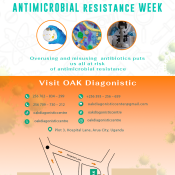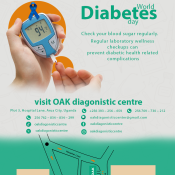MALE NOVEMBER – PROSTATE CANCER AWARENESS MONTH
What is Prostate Cancer?
Cancer is the abnormal growth of body cells which divide uncontrollably destroying and replacing the normal cells or tissues.
The human body grows by cells multiplying through a process known as cell division. This process is controlled by a person’s genes. When the genes are altered due to mutations, their ability to control cell division is hindered leading to uncontrolled cell division hence cancer.
Prostate cancer also commonly known as prostatic adenocarcinoma is a type of cancer that arise from a man’s prostate.
A prostate is a small walnut-sized gland anatomically located just below the male urinary bladder and has the urethra passing through it. It is an accessory gland for the male reproductive system that produces the seminal fluid which makes up to 30% of semen which it nourishes and helps in its the transportation. It is also useful in the process of urination.
What are the risk factors and Epidemiology of Prostate Cancer?
Any man or person born with a prostate is at a risk of developing prostate cancer but there are more specific things that raise the chances of one getting prostate cancer. Some of these factors like obesity can be changed whereas others like old age, ancestry & family history can’t be changed
Research has shown that prostate cancer is more common in males of black ancestry. Males of black ancestry are believed to have an early onset of prostate cancer.
As a man grows up the size of the prostate increases and chances of him getting prostate cancer also become high. Prostate cancer is rare in men below 40 years and 6 out of 10 cases of prostate cancer are found in men over 65 years.
According to the American Society of Cancer men with first degree relatives (brother or father) have more than double the risk of getting prostate cancer as compared to men without. The chances are more for a person with a brother than one with a father affected.
Although the exact role of diet and obesity in prostate cancer is not clear, some studies have showed that men who consume dairy products & calcium and are obese have higher risks of getting prostate cancer.
Regular vigorous exercise and a cruciferous diet can reduce on the risk of getting prostate cancer.
Prostate cancer is the commonest cancer among men worldwide with 1.2M men are diagnosed with prostate cancer every year and 350,000 die from the disease every year.
1 out of every 8 men is diagnosed with prostate cancer in their lifetime
1 out of every 40 die of prostate cancer and the average age at death being 77 years.
Signs and Symptoms of Prostate Cancer
Signs and symptoms are not normally common when prostate cancer is still in its early stages but as it progresses signs and symptoms start presenting.
Early signs include:
Slow or weak stream
- Urgency and frequency of urination. This normally occurs mostly at night.
- Blood in urine or semen.
Later signs and symptoms may include:
- Erectile dysfunction
- Back and bone pain due to metastases
- Fatigue
- Unexplained weight loss
Other than prostate cancer, there other conditions like Benign Prostatic Hyperplasia (BPH) – a non-cancerous growth of the prostate gland which also present with similar signs and symptoms so always seek medical attention when you have the signs.
Screening and Diagnosis
Screening is the testing for disease in asymptomatic individuals. For prostate cancer the PSA test is the standard screening test.
Prostate Surface Antigen (PSA) is a protein produced by prostate cells and can be detected in trace amounts in the blood. Its levels in blood increase with enlargement of the prostate which can be due to BPH or Prostate cancer.
PSA levels below 4ng/mL are considered normal
4 -10ng/mL is considered borderline and there is increased risk of having prostate cancer. 1 out of 4 people with borderline levels get prostate cancer
PSA levels above 10ng/mL are considered very high and people with that amount have higher risks of attaining prostate cancer. Half of the individuals with this amount get prostate cancer.
Because there are other conditions that increase the PSA levels like Benign Prostatic Hyperplasia, infection or inflammation of the prostate, Ejaculation, Riding a bicycle, urological procedures (e.g. biopsy) and medication especially those that increase testosterone it is advisable to repeat the PSA testing after 4 – 6 weeks of the first test.
Other forms of PSA like percent-free PSA are used after the total PSA test is taken. This is the amount of PSA that is not bound to any other protein. Prostate cancer is suspected when the level of free PSA is lower in relation to the total PSA.
Having a higher PSA reading doesn’t mean that one has prostate cancer and having a lower PSA reading doesn’t mean one has no prostate cancer because 15% of prostate cancer patients have lower PSA levels.
Once you have a high PSA reading, you’ll be advised to do a diagnostic test/examination which may include:
- Digital Rectal Examination (DRE): A doctor a gloved and lubricated finger through your rectum to feel for any stiff irregular areas that may be cancer. BPH can also present as hard lumps.
- Imaging techniques: MRI, transrectal ultrasound scan
- Biopsy: This is a definitive diagnosis where small samples (10 – 12 recommended) are removed through the perineum or rectum with ultrasound guidance. The samples are the examined by a pathologist under a microscope to know the type and extent.
Three results are expected from the biopsy: Negative for malignancy, Suspicious for malignancy and Positive for malignancy which is cancer and the cancers can be prostatic adenocarcinoma (which the commonest), squamous cell carcinoma or transitional cell carcinoma.
A biopsy result will also give you a grade and stage for your cancer.
Grading is based on how abnormal the cancer looks under the microscope. The commonest grading system is the Gleason score. Well differentiated or low-grade cancers are of Gleason score 6 and below, moderately differentiated or intermediate grade cancer have Gleason score 7 and Gleason score 8–10 is for poorly differentiated or high-grade cancers which look more abnormal, and they’re more likely to grow and spread quickly.
Staging is based on the extent of the cancer (using Tumour size, Nodes involved, and Metastases categories) and the PSA level and Gleason score when it is first diagnosed.
All these tests and examinations can be done at Oak Diagnostic Center
Treatment and Prognosis
Depending on the stage of your cancer there are different treatment options:
- Active surveillance
- Surgery (Radical prostatectomy)
- Radiation therapy
- Cryotherapy
- Hormonal therapy
- High Intensity Focused Ultrasound.
References
- Centers for Disease Control and prevention website, https://www.cdc.gov/cancer/features/prostate-cancer.html
- American Cancer Society website, https://www.cancer.org/cancer/types/prostate-cancer.html
- Rebello et al. 2021, Prostate Cancer
- Claire H Pernar et al. 2018, Epidemiology of Prostate Cancer
McHugh et al. 2022, Prostate cancer risk in men of differing genetic ancestry and approaches to disease screening and management in these groups




